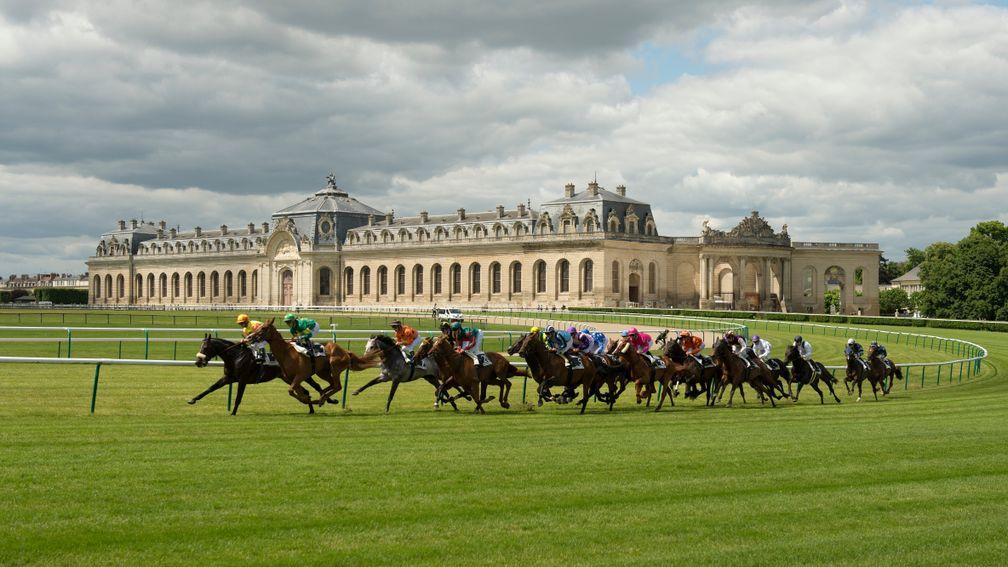The French answer to Newmarket – but twin town is Epsom
Nicholas Godfrey with some nuggets on Chantilly, home of the Prix du Jockey Club

1 Located about 40km north of Paris city centre in the district of Oise, the Hippodrome de Chantilly was built on land owned by the Duc d'Aumale adjacent to the famed Grandes Ecuries (Great Stables) and the Forest of Chantilly. The first race meeting was held on May 15, 1834. In 1886, the incumbent Duc d'Aumale donated the racecourse to the Institut de France, meaning that in effect it was owned by the state.
2 Dominating the backdrop to the racecourse are those same Grandes Ecuries, a masterpiece of 18th century architecture built in 1719 by the Louis Henri de Bourbon, seventh Prince de Condé, who lived in the nearby chateau. Clearly nutty as a fruitcake, he believed he would be reincarnated as a horse and wanted to ensure he could continue living in the luxurious fashion to which he had become accustomed. The result was the most sumptuous stables the world had ever seen; at a mammoth 186 metres long, they could accommodate 250 horses and 500 hounds (the prince was fond of his hunting). They are now home to the Living Museum of the Horse.
3 Chantilly became the nation's foremost training centre after the Duc d'Orleans transferred all his horses shortly after the establishment of the Prix du Jockey Club in 1836 and the Prix de Diane in 1843. Comprising approximately 2,000 hectares, the training centre is now home to 105 licensed trainers and about 2,500 racehorses. The greater Chantilly area also comprises the satellite communes of Lamorlaye (south) and Gouvieux (west).
4 The most famous part of the training grounds is the open plane nestled in the forest known as les Aigles (the eagles), home to a 2,600-metre round gallop, where Chantilly's finest are typically put through their paces on the Tuesday before a big Sunday's racing. Many modern-day training greats have yards bordering les Aigles: Freddy Head and sister Criquette are based on the Avenue du General Leclerc, while Alain de Royer-Dupré's own yard and the one he occupies for the Aga Khan at Aiglemont are to the north and west respectively. André Fabre's main yard is a short way across town on Avenue de Bourbon.
5 Often referred to as the French Derby and now sponsored by Qipco, the Prix du Jockey Club was inspired by and modelled on the Epsom version, being named in homage to the body that ran British racing. France's premier Classic was originally restricted to horses bred in France; the first overseas winner was the David O'Brien-trained Assert in 1982; the distance was shortened to 2,100 metres in 2005. The move is still regarded as controversial.
6 Leading jockey in the history of the Jockey Club is the legendary Yves Saint-Martin, whose record matches that of his great rival Lester Piggott at Epsom with nine victories – Reliance (1965), Nelcius (1966), Tapalque (1968), Sassafras (1970), Acamas (1978), Top Ville (1979), Darshaan (1984), Mouktar (1985) and Natroun (1987). Piggott won the race only once, on Hard To Beat (1972); Saint-Martin won at Epsom just once, on Relko (1963).
7 If the Prix du Jockey Club is the more significant race, the Prix de Diane is renowned as a more chic occasion attracting Parisian society types and fashionistas. Former sponsors include Revlon and Hermes; it is now backed by Swiss watchmakers Longines. The contest regarded as the French Oaks is named after the Roman mythological goddess Diana (Diane in French). Two fillies have won the Oaks at Epsom and Chantilly: Fille de L'Air (1864) and Pawneese (1976). The 1975 running was abandoned owing to a stable lads' strike.
8 Chantilly was a venue in the 1985 James Bond film A View To A Kill – the last with Roger Moore, theme song by Duran Duran. The estate of villainous industrialist Max Zorin (Christopher Walken) is the chateau and Bond attends a horse sale there; Bond and Zorin also clash in a steeplechase in the Forest of Chantilly. However, Ascot was used for racecourse scenes.
9 Jockeys use the Chapelle de la Mere Marie, situated about three furlongs from home, as a landmark as it signifies the point at which the track starts its ten-metre uphill climb to the winning post. "The incline starts at the Mere Marie and it is quite a strategic moment because if you launch your attack too early, you'll struggle to get home," explained Olivier Peslier. Have a look on Google maps – the chapel is located in a little copse adjacent to the track in the bottom right corner.
10 Though it is sometimes described as the French Newmarket, Chantilly is twinned with Epsom and Ewell.
Published on 3 June 2017inFeatures
Last updated 14:40, 7 June 2017
- The Gambling Commission has launched its new corporate strategy - but what are the key points?
- 'It was tragic it happened to Paddy but it was a good thing for the jockeys who followed - good came out of bad'
- Acquisitions, exits and retail resilience - what we learned from Flutter and 888's results
- The classic star named after Steve Harley: how Cockney Rebel proved to be a life-changer
- 100 years of the Gold Cup: John Randall ranks the greatest winners - and the worst
- The Gambling Commission has launched its new corporate strategy - but what are the key points?
- 'It was tragic it happened to Paddy but it was a good thing for the jockeys who followed - good came out of bad'
- Acquisitions, exits and retail resilience - what we learned from Flutter and 888's results
- The classic star named after Steve Harley: how Cockney Rebel proved to be a life-changer
- 100 years of the Gold Cup: John Randall ranks the greatest winners - and the worst